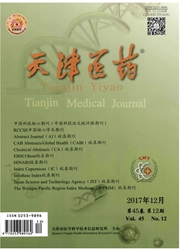

 中文摘要:
中文摘要:
目的:观察植物多糖和吡格列酮对小鼠肺腺癌的干预效果,探讨炎症和肺腺癌之间的关系,为临床肺腺癌的治疗提供理论基础。方法100只小鼠分为对照组、模型组、植物多糖组、吡格列酮组、植物多糖和吡格列酮联合干预组(联合组),每组20只;植物多糖组给予植物多糖溶液500 mg/kg,吡格列酮组给予吡格列酮溶液15 mg/kg,联合组给予500 mg/kg植物多糖+15 mg/kg吡格列酮;对照组和模型组给予等量生理盐水(10 mL/kg),均1次/d,5 d/周;共20周。观察各组不同时间小鼠肺腺癌成瘤情况,分别于第12周和20周,处死小鼠后检测各组核因子(NF)-κB、肿瘤坏死因子(TNF)-α、白细胞介素(IL)-1β和IL-6含量。结果对照组小鼠体质量平稳上升,其余组小鼠在乌拉坦注射期体质量持续下降,然后持续上升;第20周,对照组小鼠肺表面未见结节,其余组均见明显的肺结节,且小鼠肺的脏器指数明显高于对照组;在第12周和20周时,模型、吡格列酮、植物多糖和联合组小鼠体内的NF-κB、TNF-α、IL-1β和IL-6含量均高于对照组,吡格列酮、植物多糖和联合组小鼠体内的NF-κB、TNF-α、IL-1β和IL-6含量均低于模型组。结论持续的炎症反应是肺腺癌发生发展的危险因素之一,植物多糖和吡格列酮均能降低肺腺癌小鼠体内的炎症水平,提示可将其用于临床肺腺癌的药物辅助治疗。
 英文摘要:
英文摘要:
Objective To provide theoretical reference for clinical therapy of pulmonary adenocarcinoma by evaluating the effects of polysaccharides and pioglitazone on mouse model of pulmonary adenocarcinoma and to explore the relationship between inflammation and pulmonary adenocarcinoma. Methods One hundred mice were averagely divided into five groups, including control group, model group, polysaccharides group, pioglitazone group, polysaccharides and pioglitazone group (unite group). Polysaccharides solution (500 mg/kg) was given to polysaccharides group, pioglitazone solution (15 mg/kg) was given to pioglitazone group, polysaccharides solution (500 mg/kg) and pioglitazone solution (15 mg/kg) were given to unite group;and the equal volume of saline (10 mL/kg) was given to control and model group (1 t/d, 5 d/w, continuously 20 w ). The pulmonary adenocarcinoma induced by urethane was evaluated in each group at different time points. The levels of NF-κB, TNF-α, IL-1β and IL-6 were measured in each group at the 12th week and the 20th week respectively. Results The body weights were increased in the control group, which were decreased in other groups during urethane-injection, but increased continuously after the injection. At the 20th week, nodules were found in lung surfaces in all mice except mice of control group. The lung index was higher in all mice except mice of control group. The levels of NF-κB, TNF-α, IL-1βand IL-6 were significantly higher at 12th week and 20th in model group, polysaccharides group, pioglitazone group, polysaccha?rides and pioglitazone group than those of control group. The levels of NF-κB, TNF-α, IL-1βand IL-6 were significantly lower in polysaccharides group, pioglitazone group, polysaccharides and pioglitazone group than those of model group. Con?clusion Sustained inflammatory response is one of the risk factors for the development of lung adenocarcinoma. Polysaccha?rides and pioglitazone can reduce the level of inflammation in mouse lung adenocarcino
 同期刊论文项目
同期刊论文项目
 同项目期刊论文
同项目期刊论文
 期刊信息
期刊信息
